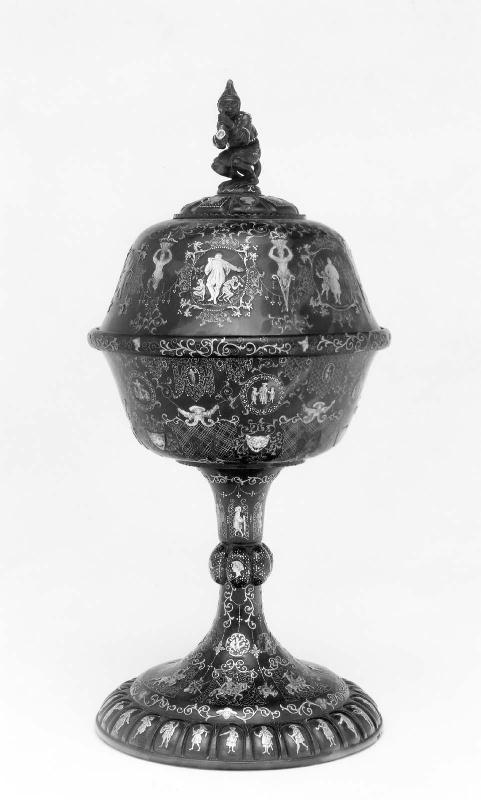Tortoiseshell standing cup and cover
mid-18th century
Object PlaceItaly (Naples) or Northern Europe
Medium/TechniqueTortoiseshell, inlaid with gold and engraved mother of pearl
Dimensionsh. 31.8 cm (12 1/2 in.) di.14.6 (5 3/4 in.)
Credit LineOtis Norcross Fund
Accession number68.20a-b
On View
On viewClassificationsVessels
Collections
This cup was surely intended as an ornamental object for a collector rather than for practical use. The laborious technique (called pique) of inlaying gold and mother-of-pearl into tortoiseshell was developed in Italy and spread across northern Europe. The decoration is loosely based on printed sources and includes asian as well as classical figures, knights on horseback, and a finial in the form of a monkey blowing a horn.
ProvenanceAlphonse de Rothschild (b. 1878 - d. 1942) and Clarice de Rothschild (b. 1894 - d. 1967), Vienna; 1938, confiscated from Alphonse and Clarice de Rothschild by Nazi forces (no. AR 2917); taken to the Kunsthistorisches Museum, stored at the Central Depot, Neue Burg, Vienna, and selected for the Führermuseum, Linz [see note 1]; 1941, removed to the monastery of Kremsmünster and subsequently to Alt Aussee; June 29, 1945, shipped by Allied forces from Alt Aussee to the Munich Central Collecting Point (MCCP no. 1479/15) [see note 2]; June 27, 1946, released from the MCCP to United States Forces in Austria, and returned to Clarice de Rothschild, New York; sold by Clarice de Rothschild to Rosenberg and Stiebel, New York; 1968, sold by Rosenberg and Stiebel to the MFA. (Accession Date: January 10, 1968)
NOTES:
[1] With the Anschluss, or annexation of Austria to Nazi Germany in March, 1938, the possessions of Alphonse and Clarice de Rothschild were seized and expropriated almost immediately by Nazi forces. This vase appears in a Nazi-generated inventory of 1939 as no. AR (Alphonse Rothschild) 2917: "Schildpattpokal, Goldpikee-Arbeit, Louis XIV." Katalog beschlagnahmter Sammlungen, inbesondere der Rothschild-Sammlungen in Wien, Verlags-Nr. 4938, Staatsdruckerei Wien, 1939, Privatarchiv, reproduced in Sophie Lillie, "Was einmal war: Handbuch der enteigneten Kunstsammlungen Wiens" (Vienna, 2003), p. 1095, no. 2917, with an annotation indicating it was destined for Linz. The Führermuseum, the art museum Adolf Hitler planned to build in of Linz, Austria, was given right of first refusal over the confiscated Rothschild collection.
[2] Many works of art stored elsewhere by the Nazis were moved to the abandoned salt mines of Alt Aussee in Austria, to be kept safe from wartime bombing. Allied troops recovered the looted artwork at the end of World War II, and established collecting points where the art could be identified for restitution to its rightful owners. This cup came to the Munich Central Collecting Point in 1945 from Alt Aussee (no. 1278/15) and was numbered 1479. The Munich Central Collecting Point inventory card is held by the National Archives and Records Administration, College Park, Maryland (Property Card 1479; National Archives Record Group 260).
NOTES:
[1] With the Anschluss, or annexation of Austria to Nazi Germany in March, 1938, the possessions of Alphonse and Clarice de Rothschild were seized and expropriated almost immediately by Nazi forces. This vase appears in a Nazi-generated inventory of 1939 as no. AR (Alphonse Rothschild) 2917: "Schildpattpokal, Goldpikee-Arbeit, Louis XIV." Katalog beschlagnahmter Sammlungen, inbesondere der Rothschild-Sammlungen in Wien, Verlags-Nr. 4938, Staatsdruckerei Wien, 1939, Privatarchiv, reproduced in Sophie Lillie, "Was einmal war: Handbuch der enteigneten Kunstsammlungen Wiens" (Vienna, 2003), p. 1095, no. 2917, with an annotation indicating it was destined for Linz. The Führermuseum, the art museum Adolf Hitler planned to build in of Linz, Austria, was given right of first refusal over the confiscated Rothschild collection.
[2] Many works of art stored elsewhere by the Nazis were moved to the abandoned salt mines of Alt Aussee in Austria, to be kept safe from wartime bombing. Allied troops recovered the looted artwork at the end of World War II, and established collecting points where the art could be identified for restitution to its rightful owners. This cup came to the Munich Central Collecting Point in 1945 from Alt Aussee (no. 1278/15) and was numbered 1479. The Munich Central Collecting Point inventory card is held by the National Archives and Records Administration, College Park, Maryland (Property Card 1479; National Archives Record Group 260).
13th-14th century
first half of 19th century
1790
Mid 18th century
16th–17th century
17th–18th century
18th century
Late 18th–early 19th century
18th century
17th–18th century

